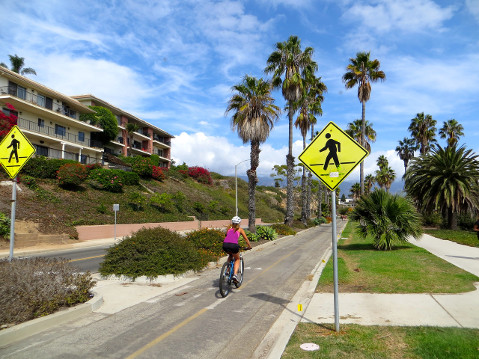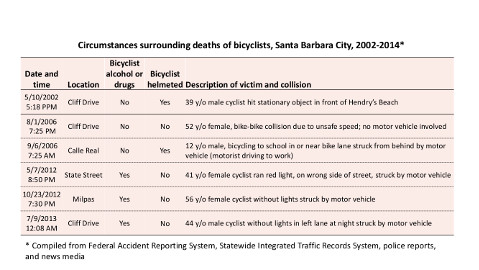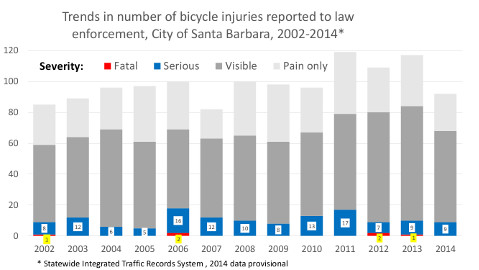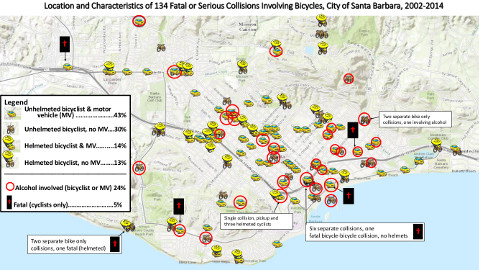How We Ran Off the Road
The Bicycle Master Plan and Bicycle Safety in Santa Barbara

Few would dispute the health and environmental benefits of riding a bicycle, and it’s hard to argue that more is not better. But concerns for safety often prevent people from biking. When the California Office of Traffic Safety (OTS) ranked our fair city worst overall (of 102 similarly sized cities) in 2012 and fourth worst for bicycle collisions, urgency was added. Our community, which is in the midst of drafting a new Bicycle Master Plan, was galvanized. However, the OTS and Santa Barbara Police statistics have been misinterpreted. Correcting these misinterpretations can lead the way to improving safety for cyclists and motorists alike.
The first source of confusion is the basis for the worst overall designation. It is based on a “composite” score that has nothing to do with collisions involving bicycles or pedestrians. Way down in the small type is the information that the composite is an aggregate of the rankings for Had Been Drinking 21-34, Had Been Drinking Under 21, Alcohol Involved, Hit & Run, Nighttime, and Speed Related collisions. The real basis for our abysmal ranking is extremely high numbers of alcohol-related motor vehicle collisions. We took third place for motor vehicle collisions involving alcohol, third for those involving underage drinking, and 14th for collisions involving intoxicated adults between the ages 21-34.
Regarding bicycle collisions, for which we were the fourth-worst mid-size city, the ignominious cities that had even more collisions were Santa Cruz, which actually took the cake for the most accidents involving a bicycle, followed by Santa Monica and Davis — all of which also have large numbers of residents who cycle to work. Presumably for simplicity, OTS did not take cyclist numbers into account, let alone the total vehicle miles traveled by this demographic. All transportation specialists use these ratios to compare the number of injuries in different populations, otherwise a community with no bicyclists and no bicycle injuries would be the safest! We should do the same when using these statistics to sway policymakers. And when we do, Santa Barbara comes out as one of the safest cities for cyclists.

It would be vile to say that Santa Barbara city saw “only” six bicyclist fatalities between 2002-2014 (listed in the table above). However, an analysis of data from government reporting agencies and news outlets points a finger not at infrastructure but at other familiar foes. Four out of six (66 percent) of the bicyclists who died were either intoxicated, in violation of traffic laws, not wearing a bicycle helmet, or some combination thereof. In one of the remaining two deaths a helmeted cyclist hit a stationary object; no car (or intoxicants) was involved. In only one case was the cyclist doing “everything right.”
We agree with Vision Zero that an average annual death count remains unacceptable as long as it is greater than zero, but we need keep a clear view of what makes it so. Most bicyclists who have died or were seriously injured were flouting basic safety principles. To do better, we must develop our Bicycle Master Plan based on data that has been accurately analyzed and correctly interpreted. Emphasis must be placed on where and why cyclists are seriously injured, not just — as is being done — on total number of collisions, the vast majority (90 percent) of which involve only minor, or no, injuries.

Improving infrastructure is but one way to prevent the kinds of deaths we have seen in Santa Barbara. Apart from violating laws, intoxication, and lack of helmets, the factors involved in serious cycling accidents and the city-wide scatter of their geographic distribution render the injuries and deaths difficult to explain.
In cities around the world, segregated bike lanes have gone a long way to reducing the rate of serious injuries while increasing cyclists, but in Santa Barbara we will need to build lots more of them and convince cyclists to use them. Until then, Safety in Numbers must ride in tandem with Safety in Safety in our move toward realizing Vision Zero.
We should not cast ourselves as the least bike-safe city in California to convince policymakers and community members that improvements to alternative transportation safety make Santa Barbara a better place to live. Increasing the use of bicycles will increase the health of the community by getting more people exercising and decreasing motor vehicle congestion. Making it clear where and how cyclists should — and ought not — commute will make Santa Barbara a better place for motorists and cyclists, no matter where it stands in the rankings.
Therefore, if we must pick principal offenders for our poor traffic safety ranking, let’s go with the one that is both logical and inarguable according to local and scientific data: alcohol. If we want to rapidly improve bicycle safety, let’s add helmets and hold the booze.

Daniel Fishbein, MD, is a seasoned researcher who recently retired to Santa Barbara, where he went to college, from the Centers for Disease Control and Prevention. Max Prior is a Harvard graduate and former UCSB employee.



